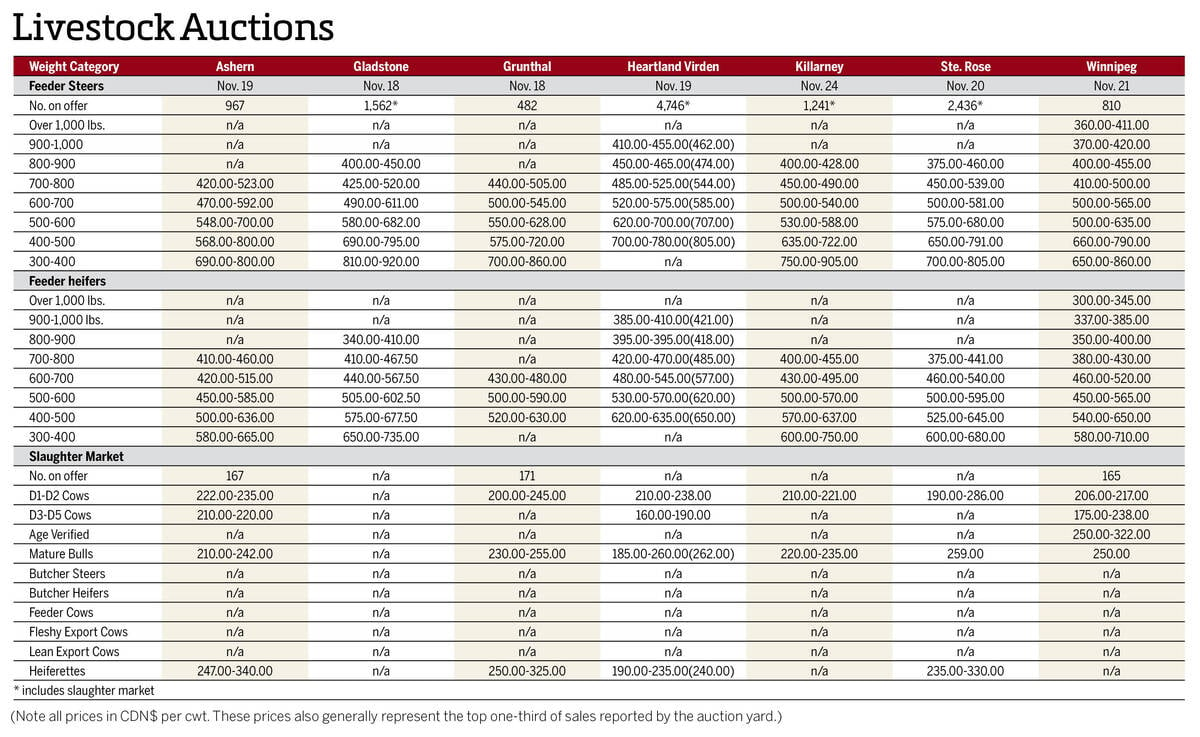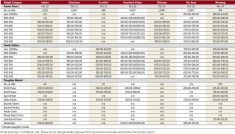Getting data back on your cattle can help producers make better decisions and earn premiums, says a leading cattle buyer.
Feedlots are moving towards a more sophisticated method of valuating cattle and that’s creating opportunities for producers, Travis Hickey told attendees at the recent Ranching Opportunities seminar in Olds.
The value for feeder cattle can be determined in a number of ways, said Hickey, general manager of Cattle Strategies at Western Feedlots Ltd. Hickey’s main duties there include feeder cattle procurement and fed cattle sales.
Read Also

Manitoba cattle prices – Nov. 24
Cattle prices from Manitoba’s major auction marts for the week of Nov. 18-24.
The traditional method is the “back of the envelope” calculation.
“We take the projected fed cattle value less the cost of gain,” he said. “What you have left is what you can pay for the feeder animal.”
But some are now adopting the Potential Variation Method to assess feeder cattle.
This method incorporates variables such as the range of the Canadian dollar, feed costs, and a range of finished weights, allowing an operator to see how much variation they can expect to see in the value of fed animals. Production variables are also modelled in this method.
“What we want to kick out is our potential probability of being profitable,” said Hickey. “So we do this for all the different weight classes available in the marketplace at a given time.”
Western Feedlots uses another method when selling cattle.
“The value of a carcass under our selling methods is determined through a combination of the base price times by the carcass weight of the animal, plus any grid premiums or discounts given to us through signals from the packer,” Hickey said.
Tools such as ultrasound are used to predict the quality of an animal’s carcass. The grid value represents about two per cent of the total revenue to the feedlot. The other 98 per cent is a combination of the base price times it by carcass weight, said Hickey.
“That’s not to say that the grid or carcass quality isn’t important because that two per cent is often the difference between being profitable or not,” he said.
INDIVIDUAL ANIMAL MANAGEMENT
Western Feedlots uses the principle of individual animal management (IAM) to try and get individual animals to reach their most economically optimal endpoint.
“That might mean one carcass weight for one class of animals and another carcass weight for a different class of animals,” Hickey said.
They research factors such as placement weight, marketing weight, colour, height, body condition, days on feed, and target weight.
All of the research data received is then linked back to individual carcasses so Western Feedlots can track how different management interventions affect the profitability of an animal. This research is largely done in a facility at the High River feedlot, built about three years ago.
“Through management interventions or IAM-type sorting culls, we can take animals and alter their carcass composition to extract more value or less value,” he said. “We can take an inferior animal and turn it into a very good carcass, for example.”
Over time, Western Feedlots is making more use of individual animal traits and using that data to predict the carcass characteristics of those animals. Carcass data is only one part of a very complex puzzle, said Hickey. Feeder value is about 60 per cent of the total cost of a finished animal, he said.
Additional factors such as purchase price, projected fed cattle value, implants, vaccines, and treatments affect value and profitability, he said. However, managing and accounting for a wide variety of factors, such as health can have important implications for profitability.
So what can producers do to get more value from their cattle?
Hickey advises developing a relationship with a feeder, feedlot owner or order buyer in order to receive data on their cattle.
“If you are going to go through a traditional type of an auction market setting, understand what the associated costs are to you as a cattle producer when you sell that way,” he said.
These costs can include shrink, selling commission and sorting.
“If you’re going to feed your own cattle, you need to understand whether you are going to sell on a live-based price,” said Hickey. “If you are, carcass data may not mean a whole lot to you.
“If you’re going to sell on flat rail price, all of a sudden your feed to gain and your endpoint become very important. If you’re going to feed your own cattle and sell them to a Western-based or a grid-or value-based marketing program, that carcass quality is very important.”
It all comes down to differentiating your cattle from others by providing information that helps feedlot operators better determine the value of your cattle.
“The point is if you’re going to feed your own cattle, you need to understand how you’re going to sell them and what you’re going to get paid for.”
———
“Wecantakean inferioranimaland turnitintoaverygood carcass,forexample.”
– travis hickey














